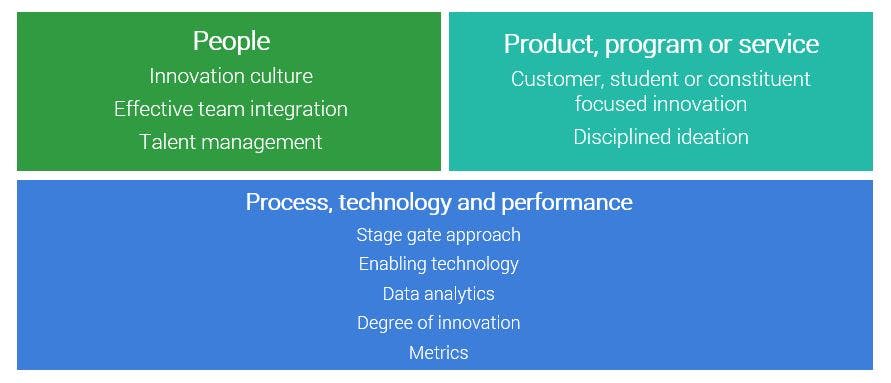
Article
Thriving innovation culture supports effective change throughout the organization
Innovation is important for any organization, whether it’s a business, government entity, not-for-profit, or college or university. It’s the difference between being wildly successful and just surviving. Innovation looks very different based on what type of entity you are, what is occurring in your marketplace, where you are operating, and who you're competing against.
Baker Tilly managing director Christine Smith and senior manager Claudio Garcia, at a Baker Tilly webinar, highlighted four key aspects of innovative cultures:
- Innovation drives value to the market and helps organizations focus on what needs to change to continuously provide that value. Markets don’t stand still; constituent needs constantly evolve. Therefore, organizations can’t stand still, either.
- Innovation should be an expected part of an organization's culture and empower people throughout the organization, coupled with specific incentives for recognizing innovative thoughts and decision-making.
- Accepting failure as a possibility is essential. Many organizations don't communicate well that it's OK to fail, and that failure often is a step toward meaningful change.
- Both big “I” innovation and little “I” innovation are encouraged; anything (within reasonable boundaries) that enhances value or improves organizational efficiency, effectiveness or responsiveness should be welcome.
Smith noted familiar innovations, like Uber, DoorDash, Tesla and Volt, all revolutionized by doing things specifically in response to changing customer needs. She said, “Some emerging innovations across industries served by Baker Tilly include esports, digital textbooks, healthcare self-service and robotic process automation. All spring from a customer need perspective, and that perspective should drive innovative organizations to manage talent, design processes and report results.”
The speakers highlighted three fundamental innovation success drivers and specific capabilities that are necessary for an organization to truly support an innovative culture :
People
As part of the “people” success driver, Smith said that organizations with a culture of innovation should consider both external innovation (serving customers or constituents) but also internal innovation (streamlining processes or providing the right tools or training). Organizations also need to learn how to “fail forward,” where managers or employees are not penalized for ideas that don’t work, but given the time to understand why something failed and then recalibrating as necessary. Organizations should create an award system for innovation that is fair and transparent across all levels of the organization.
Effective team integration requires teams across an organization to work together to operationalize and implement specific innovative ideas. Smith said, “Often, we find that our clients understand at the top levels of the organization what the innovation goal is, but as you get further down in the organization, each individual doesn't always necessarily understand how they contribute to the success and how an innovation may or may not impact them.”
The final piece of the people success driver is talent management. Organizations have to ensure they have employees with the right competencies but also the capacity to think innovatively and strategically about what's needed to differentiate the organization in the marketplace.
Product, program or service
Garcia said that an innovation should be on point with customer or constituent expectations, validated through qualitative and quantitative research. He said, “the key is to engage a cross-functional group within the organization to generate those ideas and, importantly, to have an effective way of ranking and prioritizing those ideas based on effective criteria and filtering that makes the most sense for your organization.”
Smith noted two examples of innovative ideas emerging in the realm of higher education. One is the increase in university-based retirement communities, which leverages a partnership between a university and a private sector housing developer for senior living. The partnership includes the university offering programming that occurs within that senior living community, as well as both educational and employment opportunities for students.
The other example involves esports, which may have started as another club sport option on some campuses but has grown to where, at some colleges and universities, esports is an academic program, providing students the opportunity for experiential learning – combining traditional classroom-based credits with real life esports competition.
Process, technology and performance
This success driver utilizes data and technology to help an organization validate what it is trying to accomplish through its people and its products, programs or services us resonating in the market. For example, the “stage gate” approach provides a structure for an organization to identify decision-making milestones where feasibility and risk are assessed throughout an innovation process. This also includes a post-launch assessment where a product, program or service is adjusted based on early results.
Garcia said, “We want to minimize the guesswork and the subjective opinions in our innovation development. We can optimize that by leveraging technology, research and data to create a fact-based decision-making culture related to our innovation strategy.”
Smith added, “We can't emphasize enough the criticality of leaders and employees across the organization believing that they can truly make a difference by challenging themselves to think beyond the status quo.”
The webinar was held in conjunction with the release of the e-book “Innovation culture – jumpstarting new ideas to drive organizational success.”

